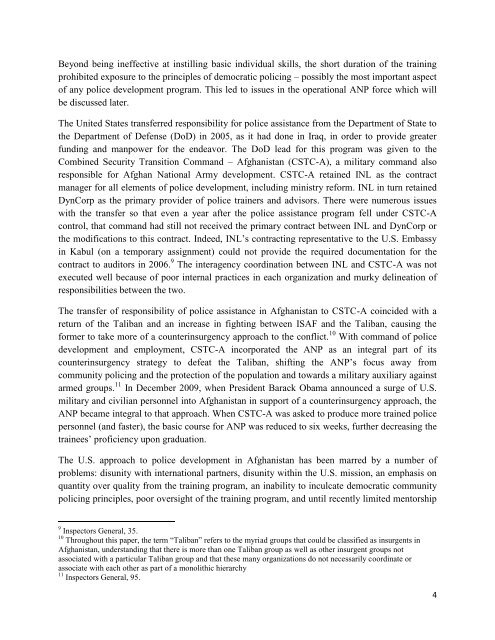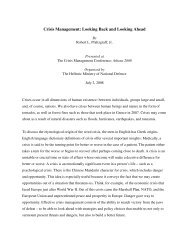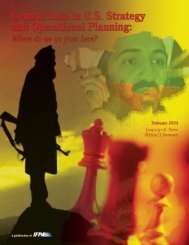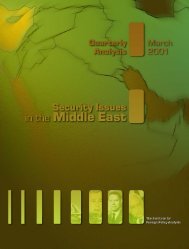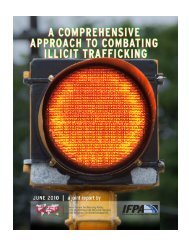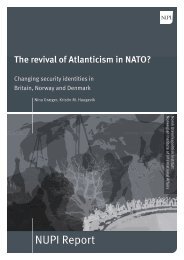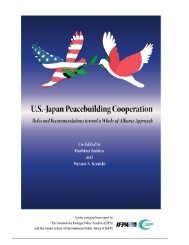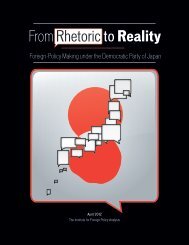US Peacebuilding in Afghanistan - Institute for Foreign Policy Analysis
US Peacebuilding in Afghanistan - Institute for Foreign Policy Analysis
US Peacebuilding in Afghanistan - Institute for Foreign Policy Analysis
Create successful ePaper yourself
Turn your PDF publications into a flip-book with our unique Google optimized e-Paper software.
Beyond be<strong>in</strong>g <strong>in</strong>effective at <strong>in</strong>still<strong>in</strong>g basic <strong>in</strong>dividual skills, the short duration of the tra<strong>in</strong><strong>in</strong>gprohibited exposure to the pr<strong>in</strong>ciples of democratic polic<strong>in</strong>g – possibly the most important aspectof any police development program. This led to issues <strong>in</strong> the operational ANP <strong>for</strong>ce which willbe discussed later.The United States transferred responsibility <strong>for</strong> police assistance from the Department of State tothe Department of Defense (DoD) <strong>in</strong> 2005, as it had done <strong>in</strong> Iraq, <strong>in</strong> order to provide greaterfund<strong>in</strong>g and manpower <strong>for</strong> the endeavor. The DoD lead <strong>for</strong> this program was given to theComb<strong>in</strong>ed Security Transition Command – <strong>Afghanistan</strong> (CSTC-A), a military command alsoresponsible <strong>for</strong> Afghan National Army development. CSTC-A reta<strong>in</strong>ed INL as the contractmanager <strong>for</strong> all elements of police development, <strong>in</strong>clud<strong>in</strong>g m<strong>in</strong>istry re<strong>for</strong>m. INL <strong>in</strong> turn reta<strong>in</strong>edDynCorp as the primary provider of police tra<strong>in</strong>ers and advisors. There were numerous issueswith the transfer so that even a year after the police assistance program fell under CSTC-Acontrol, that command had still not received the primary contract between INL and DynCorp orthe modifications to this contract. Indeed, INL’s contract<strong>in</strong>g representative to the U.S. Embassy<strong>in</strong> Kabul (on a temporary assignment) could not provide the required documentation <strong>for</strong> thecontract to auditors <strong>in</strong> 2006. 9 The <strong>in</strong>teragency coord<strong>in</strong>ation between INL and CSTC-A was notexecuted well because of poor <strong>in</strong>ternal practices <strong>in</strong> each organization and murky del<strong>in</strong>eation ofresponsibilities between the two.The transfer of responsibility of police assistance <strong>in</strong> <strong>Afghanistan</strong> to CSTC-A co<strong>in</strong>cided with areturn of the Taliban and an <strong>in</strong>crease <strong>in</strong> fight<strong>in</strong>g between ISAF and the Taliban, caus<strong>in</strong>g the<strong>for</strong>mer to take more of a counter<strong>in</strong>surgency approach to the conflict. 10 With command of policedevelopment and employment, CSTC-A <strong>in</strong>corporated the ANP as an <strong>in</strong>tegral part of itscounter<strong>in</strong>surgency strategy to defeat the Taliban, shift<strong>in</strong>g the ANP’s focus away fromcommunity polic<strong>in</strong>g and the protection of the population and towards a military auxiliary aga<strong>in</strong>starmed groups. 11 In December 2009, when President Barack Obama announced a surge of U.S.military and civilian personnel <strong>in</strong>to <strong>Afghanistan</strong> <strong>in</strong> support of a counter<strong>in</strong>surgency approach, theANP became <strong>in</strong>tegral to that approach. When CSTC-A was asked to produce more tra<strong>in</strong>ed policepersonnel (and faster), the basic course <strong>for</strong> ANP was reduced to six weeks, further decreas<strong>in</strong>g thetra<strong>in</strong>ees’ proficiency upon graduation.The U.S. approach to police development <strong>in</strong> <strong>Afghanistan</strong> has been marred by a number ofproblems: disunity with <strong>in</strong>ternational partners, disunity with<strong>in</strong> the U.S. mission, an emphasis onquantity over quality from the tra<strong>in</strong><strong>in</strong>g program, an <strong>in</strong>ability to <strong>in</strong>culcate democratic communitypolic<strong>in</strong>g pr<strong>in</strong>ciples, poor oversight of the tra<strong>in</strong><strong>in</strong>g program, and until recently limited mentorship9 Inspectors General, 35.10 Throughout this paper, the term “Taliban” refers to the myriad groups that could be classified as <strong>in</strong>surgents <strong>in</strong><strong>Afghanistan</strong>, understand<strong>in</strong>g that there is more than one Taliban group as well as other <strong>in</strong>surgent groups notassociated with a particular Taliban group and that these many organizations do not necessarily coord<strong>in</strong>ate orassociate with each other as part of a monolithic hierarchy11 Inspectors General, 95.4


